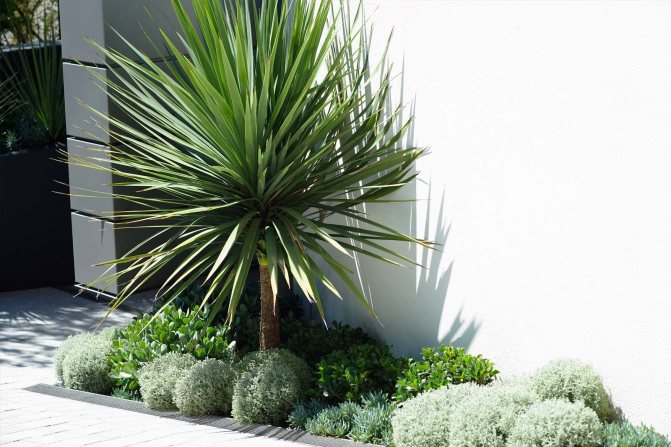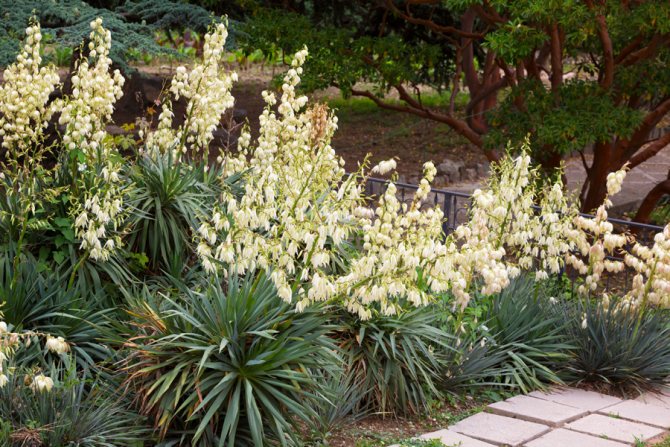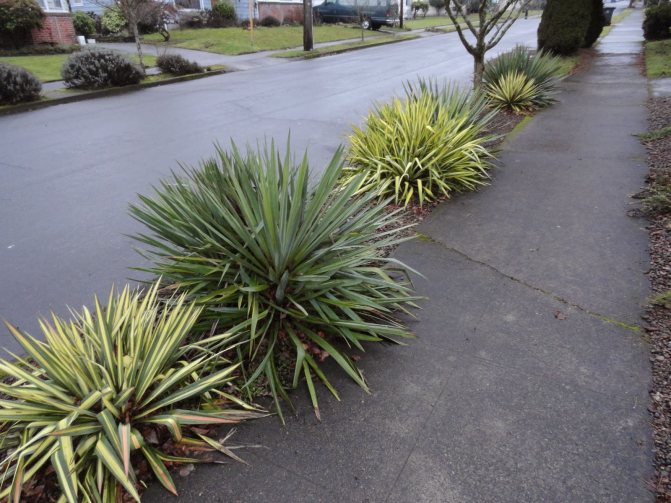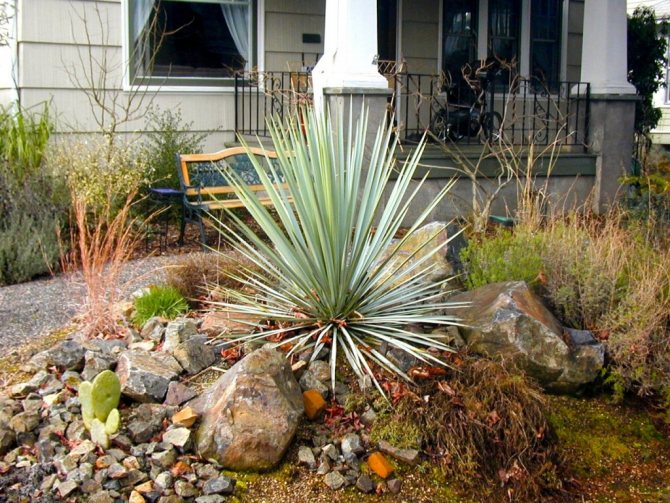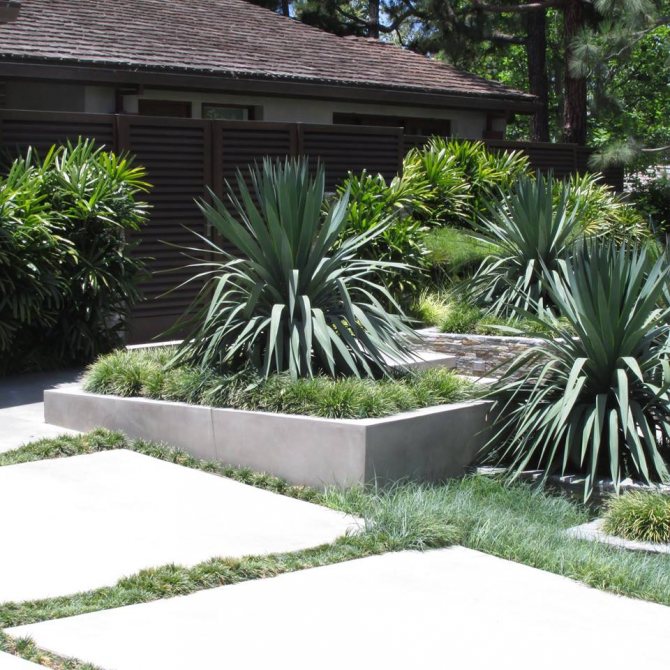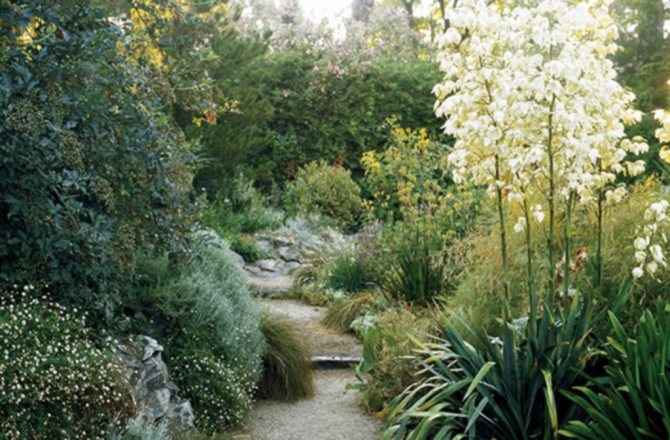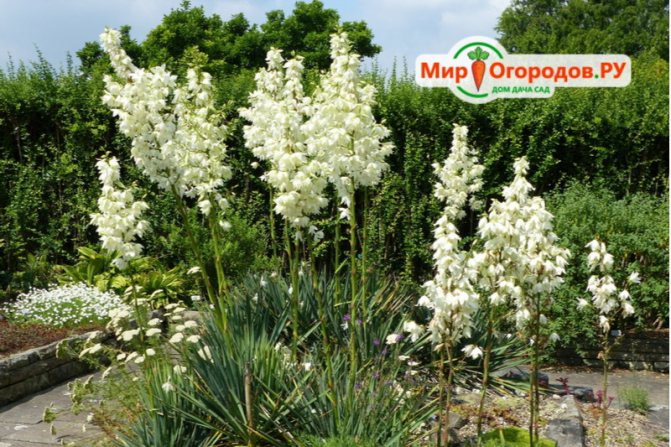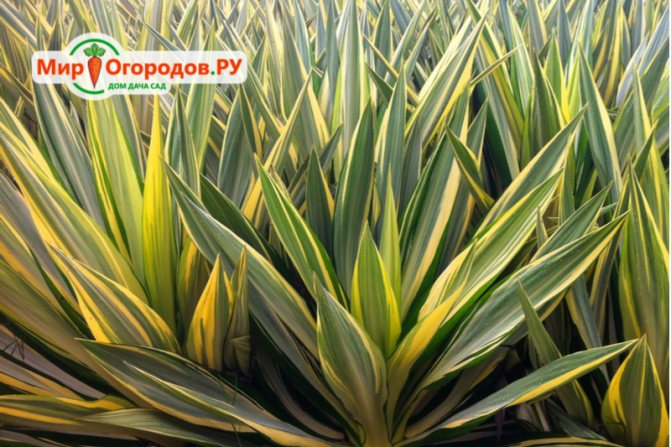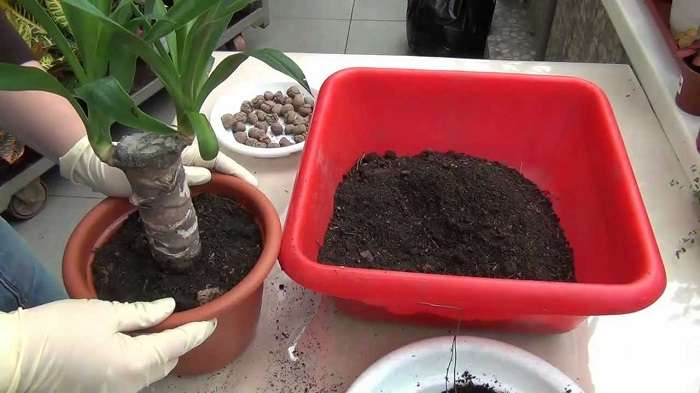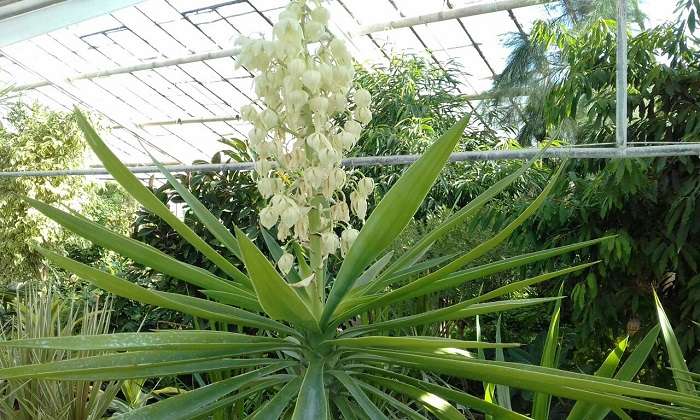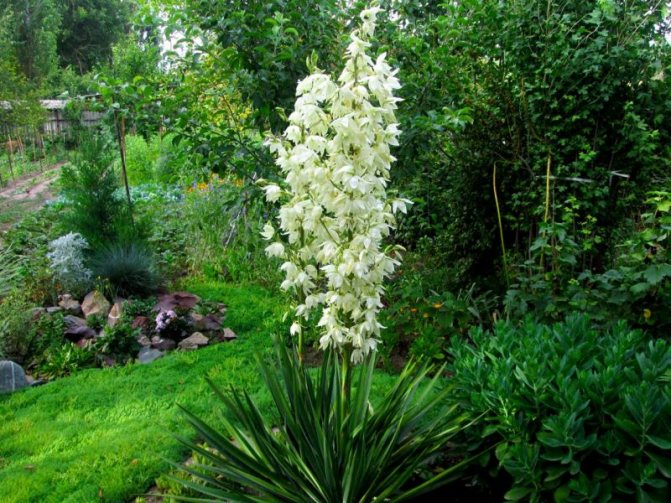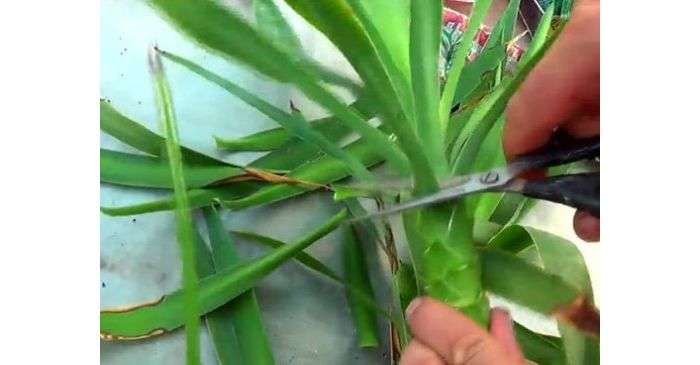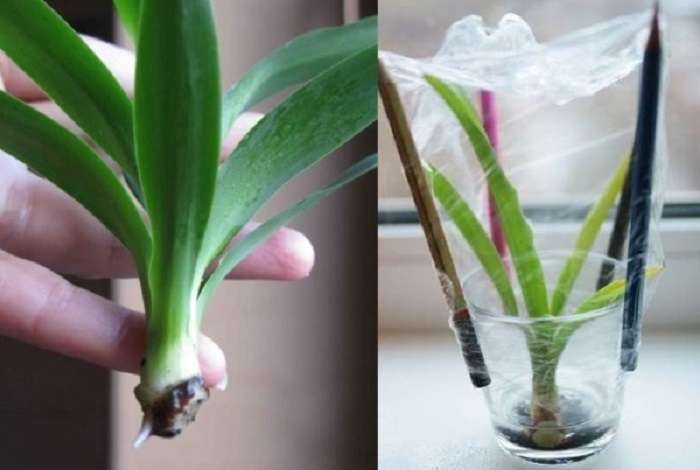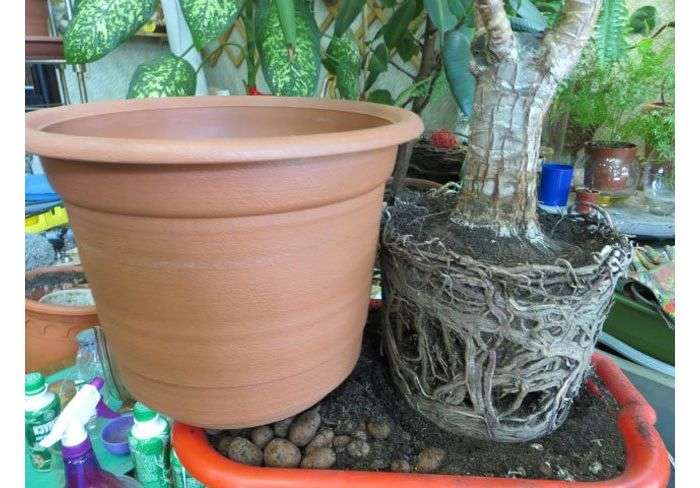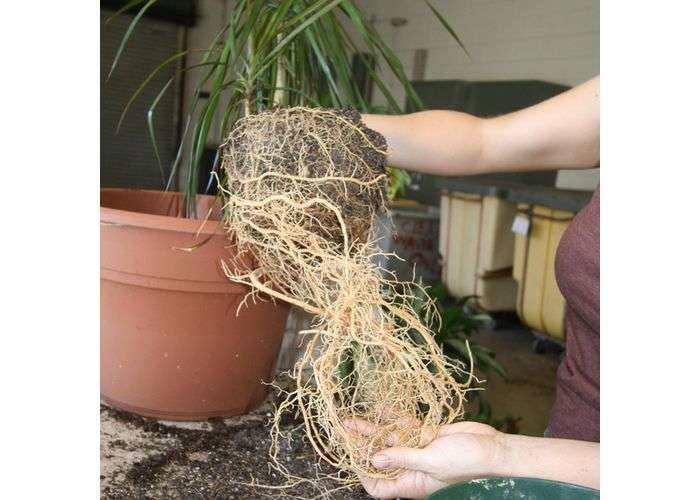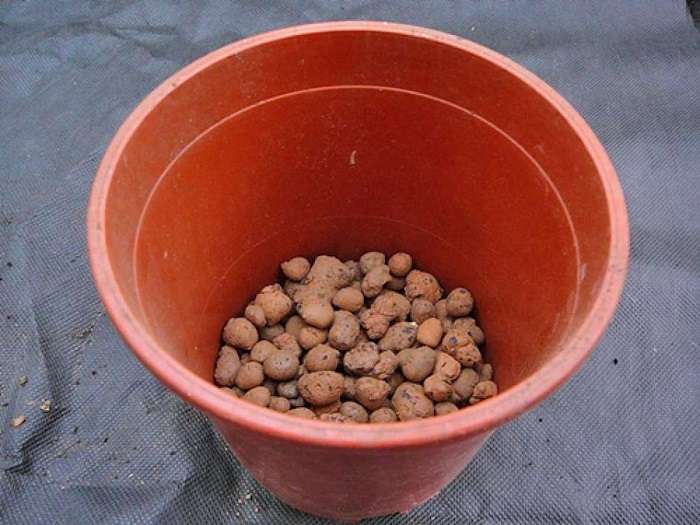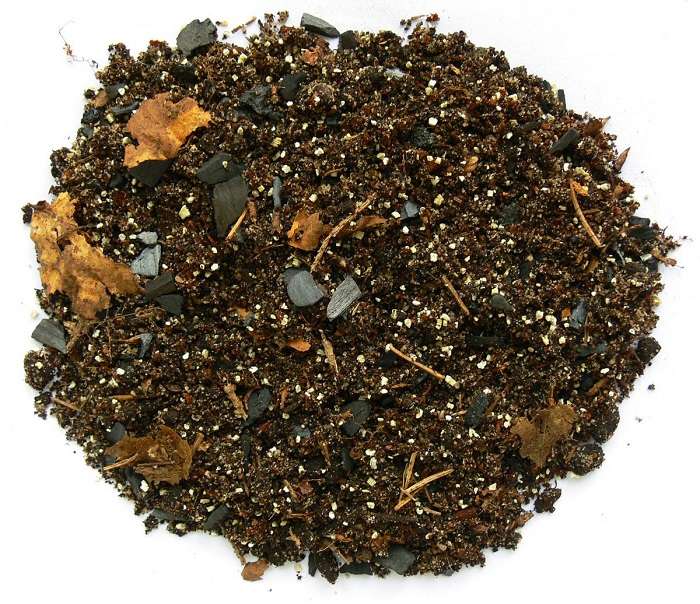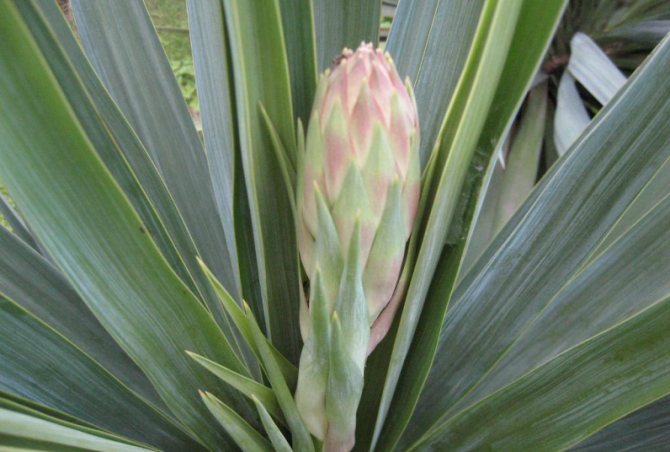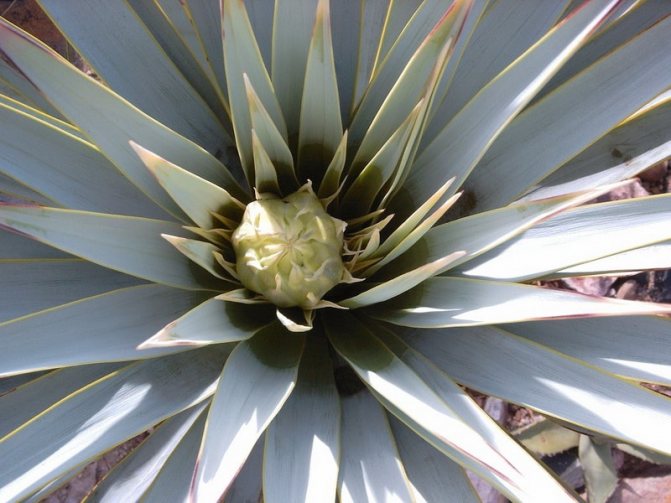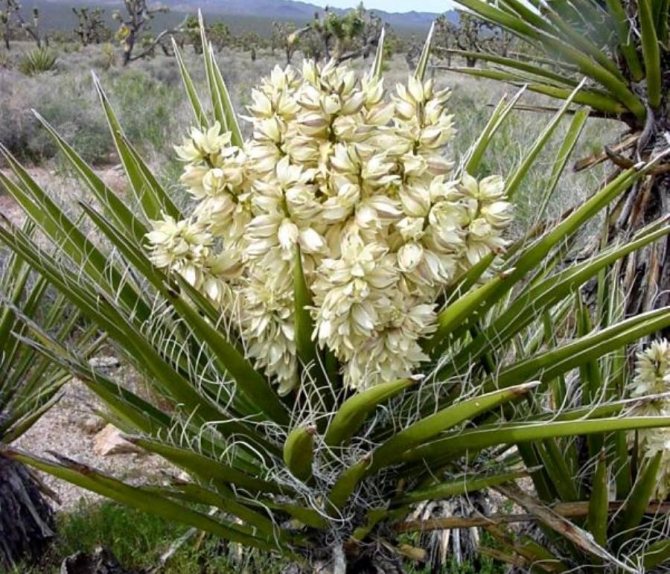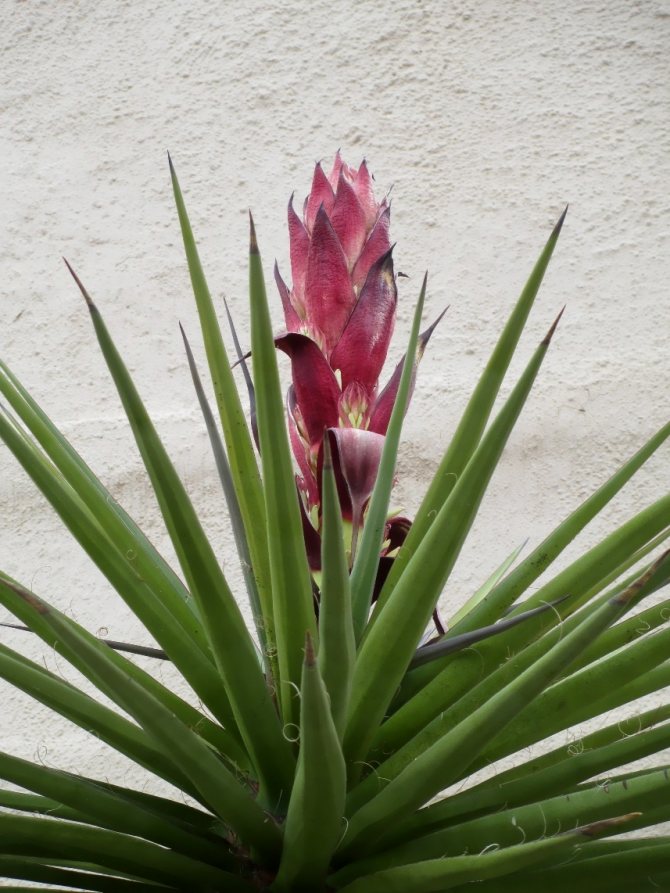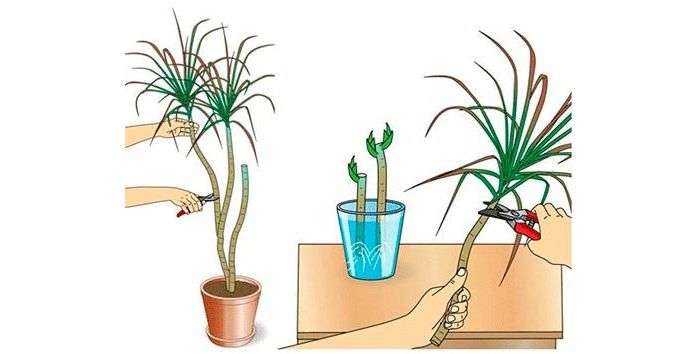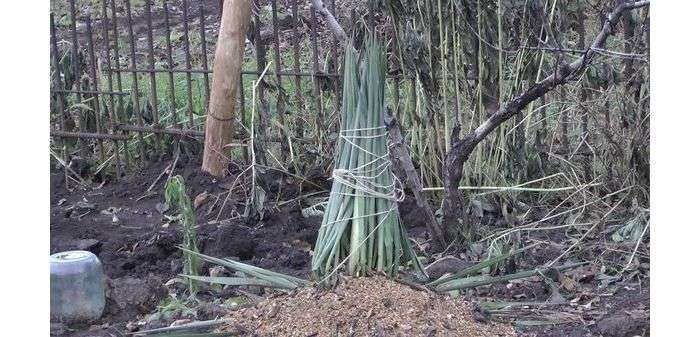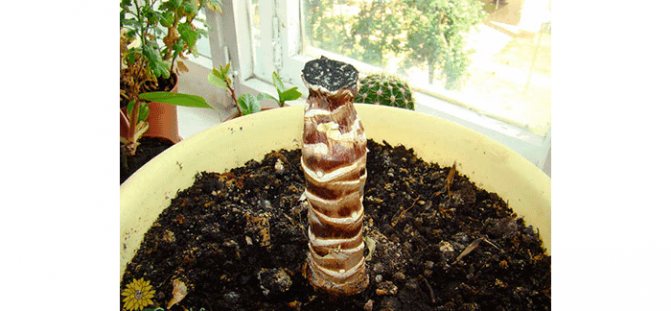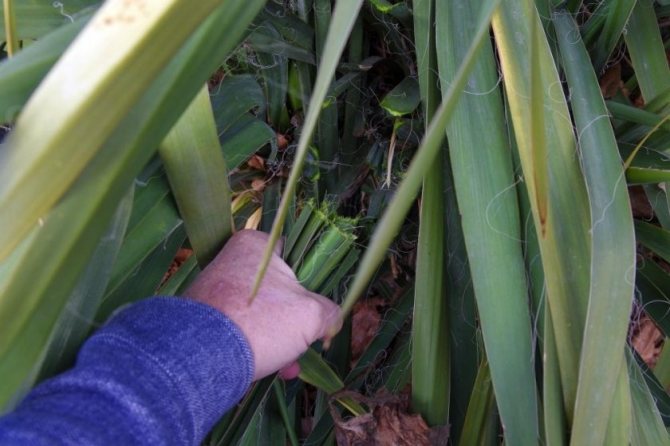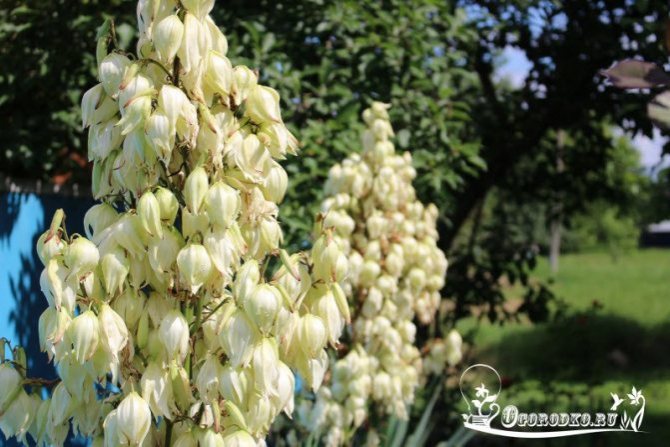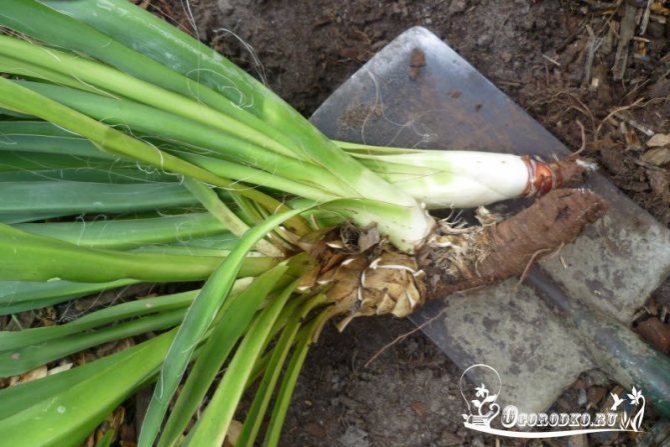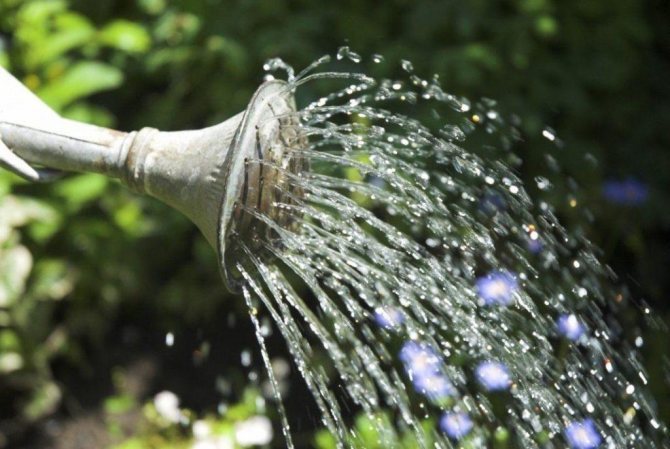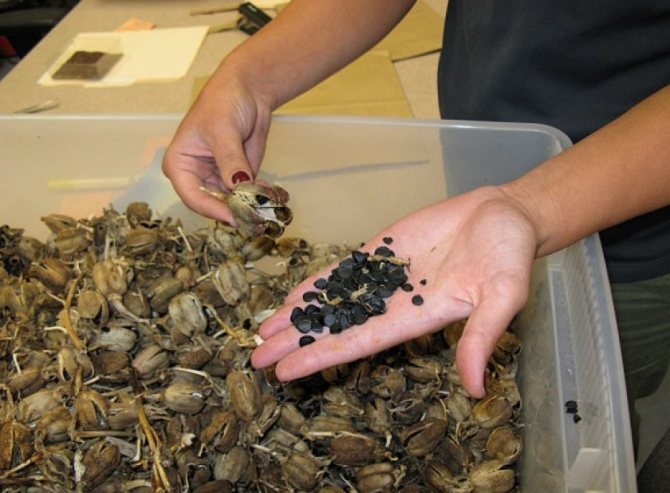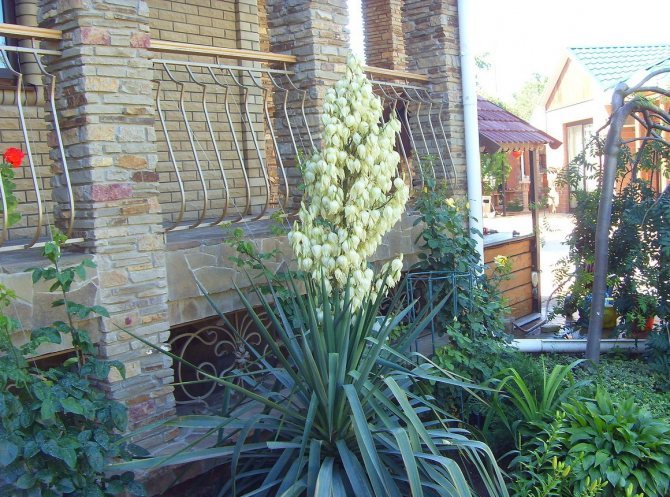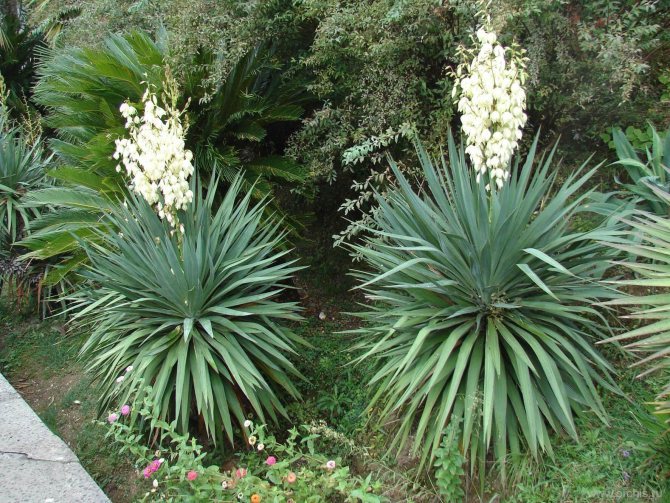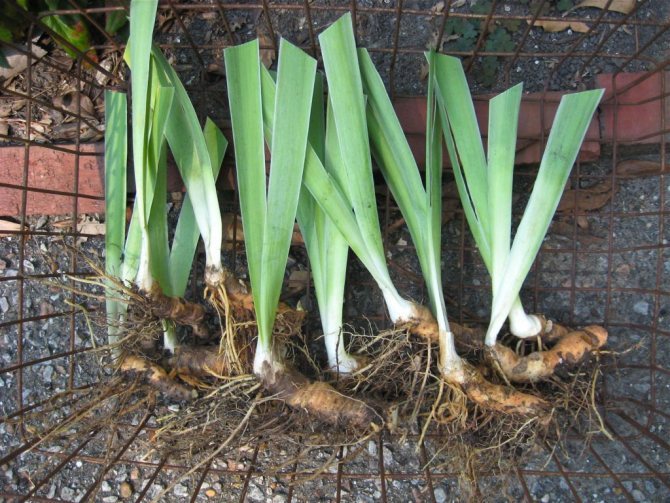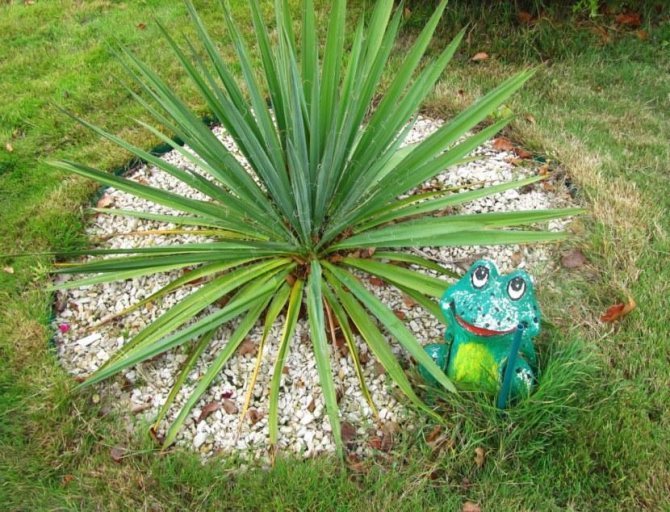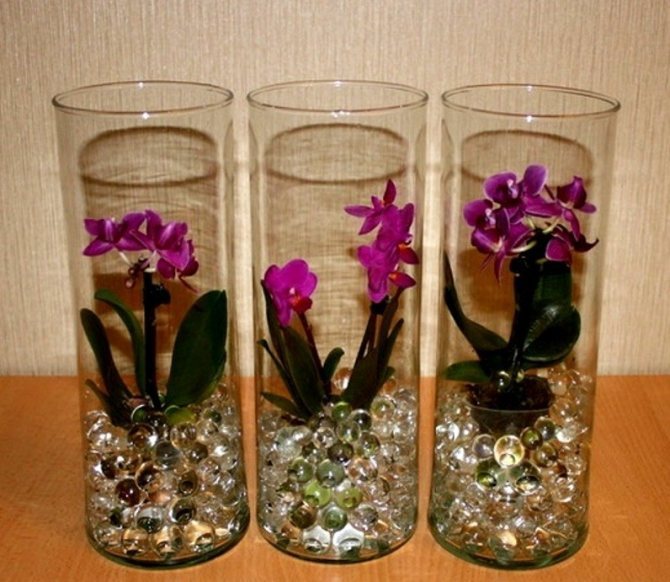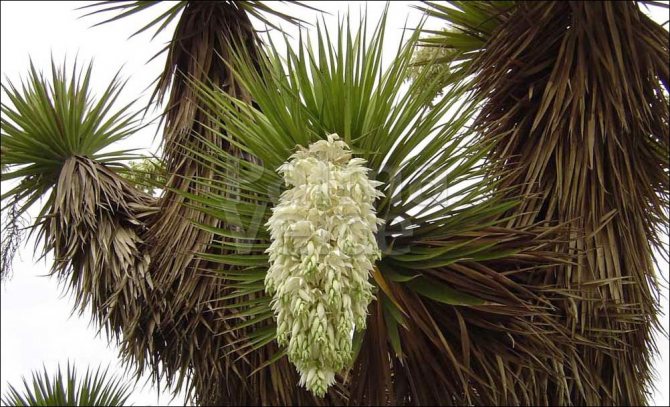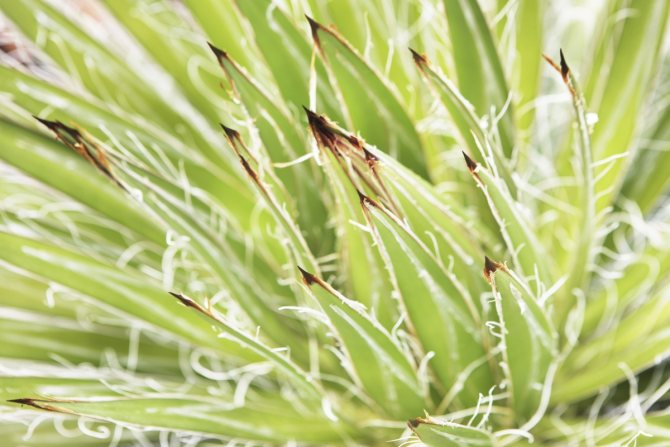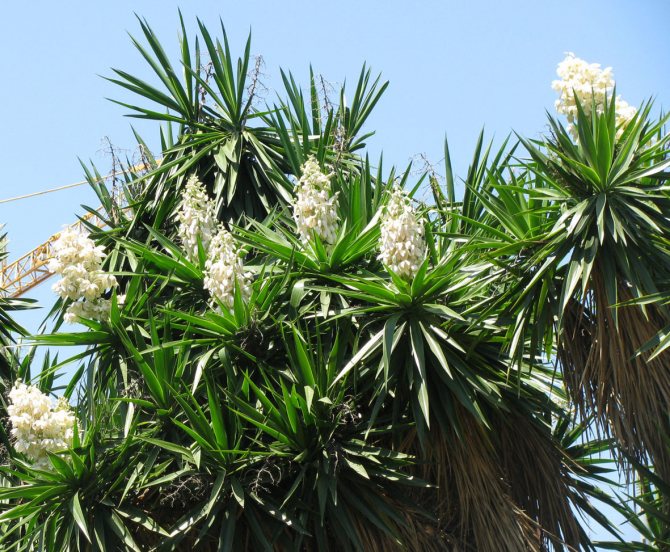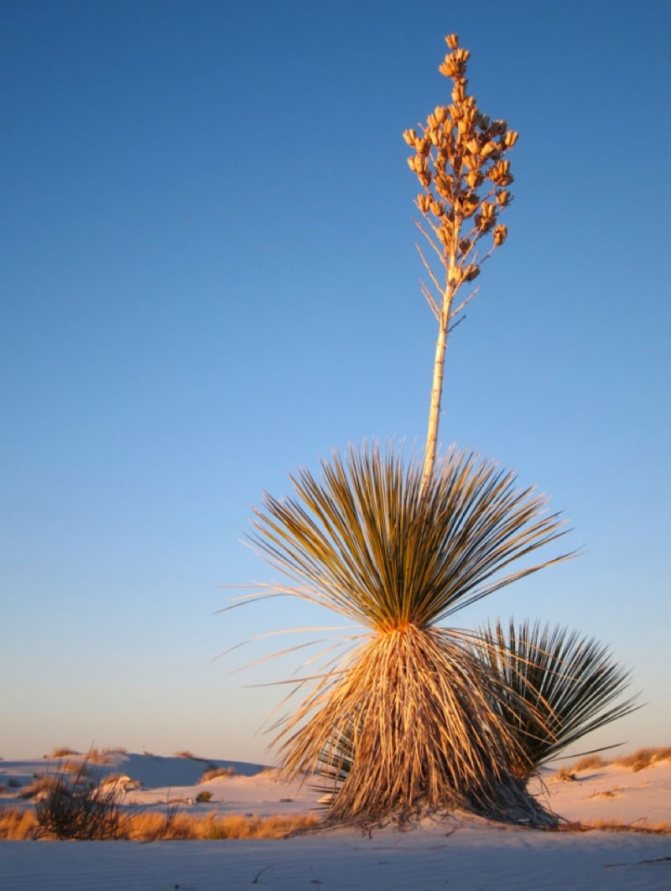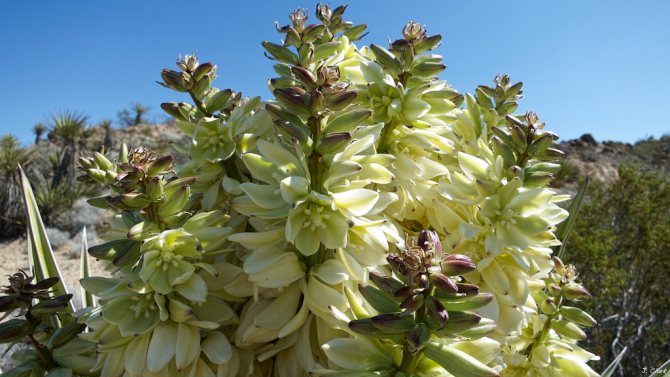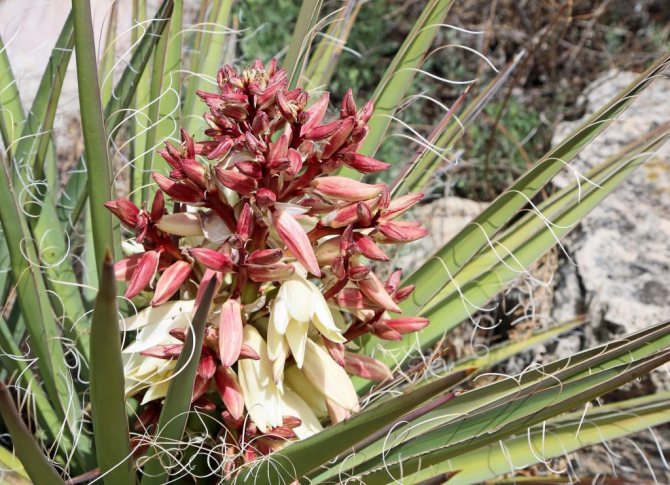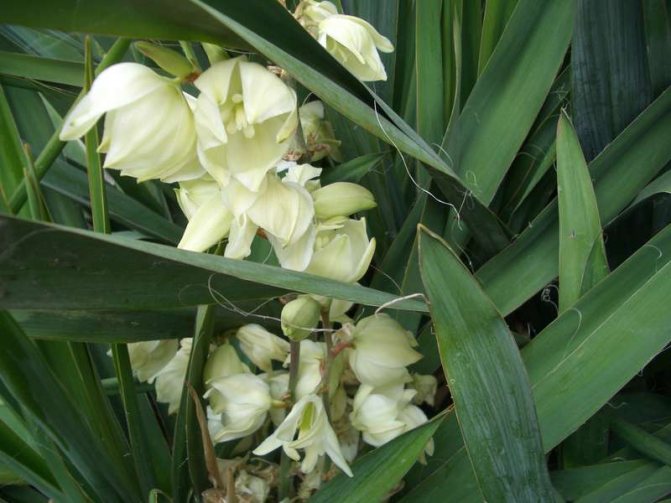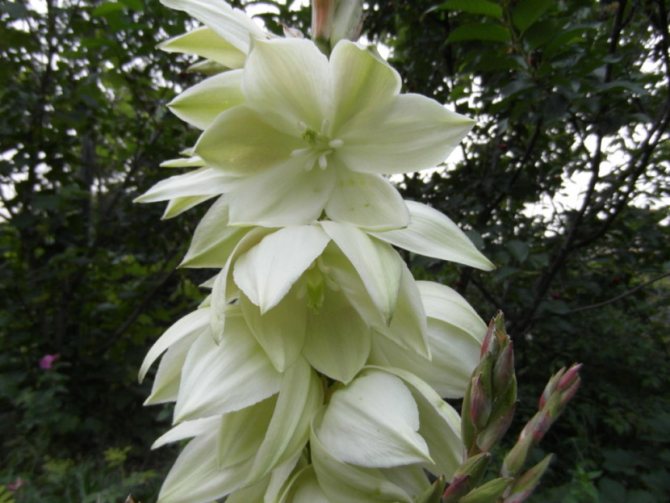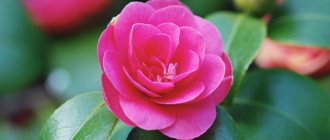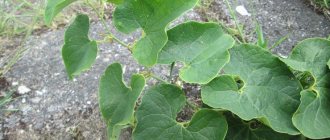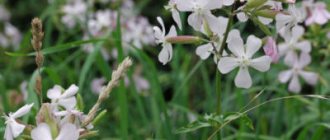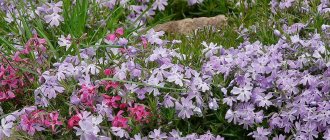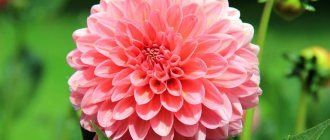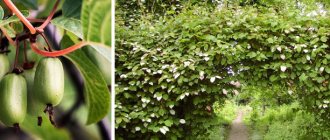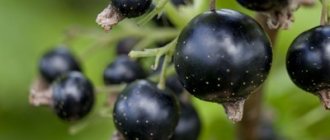Yucca description
When cultivated in the open ground of central Russia, 3 types of yucca are practiced:
- filamentous - this shrub got its name for the thin fibers hanging along the edges of the hard leaves. This is one of the most frost-resistant yucca species, capable of withstanding up to -30 ° C for a short time. Its almost stemless rosette consists of spirally arranged, erect, blue-green xiphoid leaves about 70 cm long and up to 4 cm wide, pubescent with twisting threads. When flowering, it throws out a flower panicle up to 2 m tall, densely covered with drooping, yellowish-white flowers, in place of which, after flowering, seed pods up to 5 cm in diameter are formed. A variety of filamentous yucca are variegated forms - shrubs with white or yellow-feathery leaves. The most common variegated varieties of filamentous yucca are Bright Edge and Color Guard, Gold Heart, Ivory Tower;
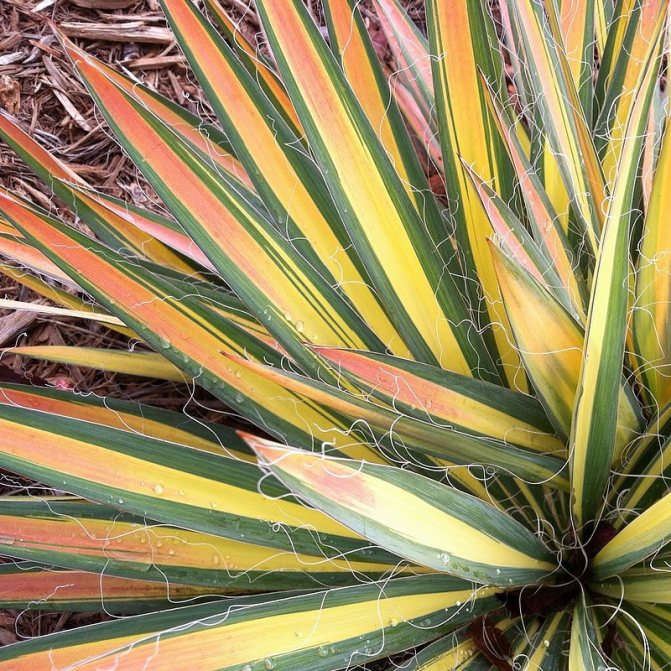
- glorious - a type of yucca that grows into a spherical bush or tree up to 2 m tall. The dark green leaves of this shrub have a bluish bloom, serrated along the edge, with a thorny thorn at the top of the leaf. The length of the leaf plate reaches 60 cm. Its peduncle is up to 2.5 m in height, covered with large creamy-purple bell-shaped flowers.


- gray-gray - a type of yucca, characterized by a short trunk, long narrow gray-green leaves and a tall peduncle with a racemose inflorescence of greenish-white flowers. Another name for this species is "The Lord's Candle".
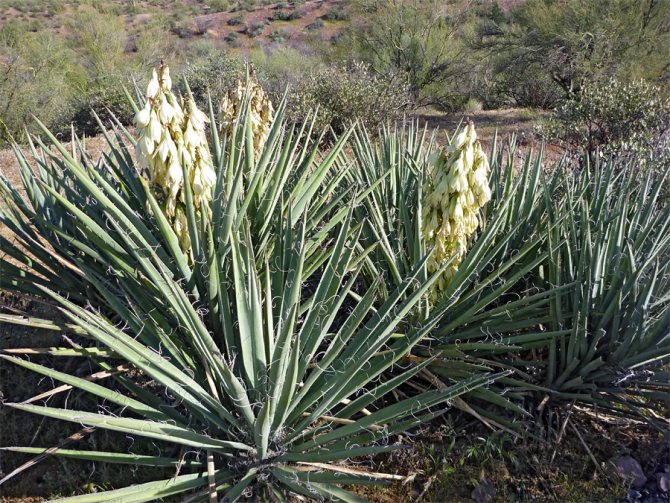

In the southern regions, elephant yucca, leafy yucca, Shidigera yucca, rostrata yucca, shotti yucca, aloe yucca, gloriosa yucca and other species also grow well.
Yucca blooms usually 3-5 years after planting in June or July. When grown in southern regions, it can bloom twice a year - in summer and autumn. In landscape design, yuccas are used in single and group plantings, planting in rockeries, in flower beds, along fences.
Yuka garden flower - care, planting
At the end of planting, the yucca must be equipped with small irrigation, cleaning processes, periodic soil fertilization and pruning. Sanitary work must include the elimination of dead leaves and peduncles.
Temperature and lighting in the garden
Garden yucca is very fond of sun and warmth. For this reason, it is necessary to plant it in free and well-lit places. Partial shade will also do. The flaw in light leads to the fact that the crown is made the least rich. Dryness is not terrible for the plant. Reproduction is carried out at a temperature of approximately 20 degrees. Severe winters are not terrible for yucca if it is successfully and effectively hidden.
Humidity and watering
The land should not be intensely wet, since the plant does not like powerful moisture and rich watering. The leaves speak about the need for watering: when they are smoothed out, and the threads are slightly wrapped around the edges, there is no need for watering, and if the leaves curl up and the threads drop, then the plant needs watering. In winter, garden yucca is equally required to irrigate, but much less. It is very important to avoid over-watering during the winter. Such has the ability to plunge into decomposition of the roots.
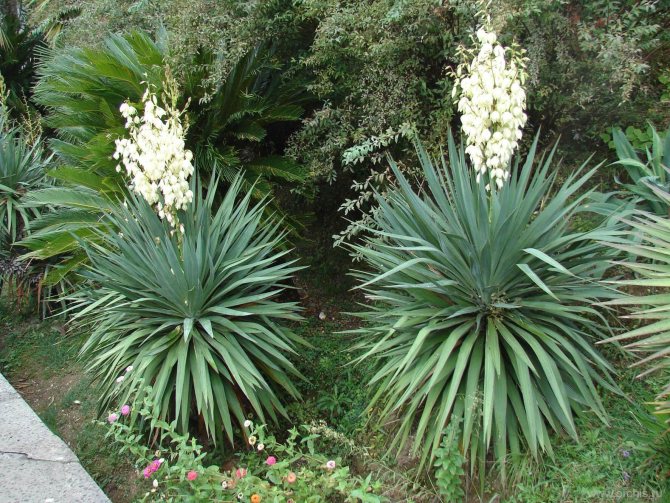

garden yucca - planting and care, photo
It is necessary to irrigate the yucca directly to the root.In no case should the plant be poured, since stopping the liquid in the ground is the root cause of decay of the root system and, subsequently, of the entire plant.
Top dressing
Filamentous yucca does not need a huge share of top dressing. Hardly only in the spring is it recommended to fertilize it with mineral subcrust. The plant will not need nitrogen fertilizers. Excess nitrogen has the ability to plunge the plant into death. The main fertilizers should be applied in May, at this time the growing season begins, and the next one, at the time when the flowering of the plant ends.
Yucca pruning
Shearing culture rejuvenates it and allows you to find strong young saplings. This method is used if the plant is frozen over in winter or the roots have begun to rot. In the spring, at a time when the culture is no longer under winter cover, the stem is pruned. With this, the future growth of the plantation is interrupted, and dormant buds are activated to awaken, which will provide the emergence of the newest rosettes with leaves.
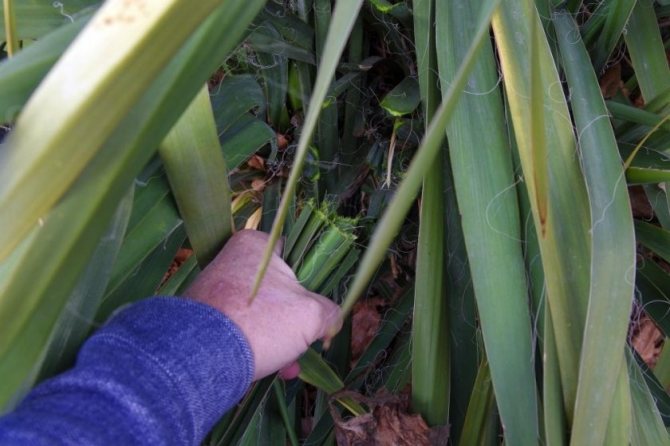

- Before cutting, the crop should be well watered.
- You need to cut the stem below the growing leaves by 6-9 cm.
- At the end of drying, the areas of the cut are sprinkled with charcoal.
Outdoor transplant
If a culture grows in one place for a long time, it expands very much. As a result, filamentous yucca requests picks. In another area, the plant will bloom profusely and grow more beautifully. But you do not need to make a dive very often.
How to make a pick:
- It is recommended to make a pick at the end of summer or in the spring period of time;
- When digging up the culture, you must try not to harm the root system. It is very important to remember that the roots have every chance of being removed into the ground by 70 cm;
- Shoots, which can form next to a bush, must be dug up and planted as separate bushes;
- The microenvironment in the other area should be the same as in the previous one;
- A dive plant needs fertilization.
Wintering Yucca
Despite the fact that garden yucca very easily adapted to the harsh climate of the middle zone, it is impossible to save it for the winter period without the necessary shelter. Because from cold frosts, the culture can suffer or completely die. One of the methods described below is possible to insulate an outlandish plant.
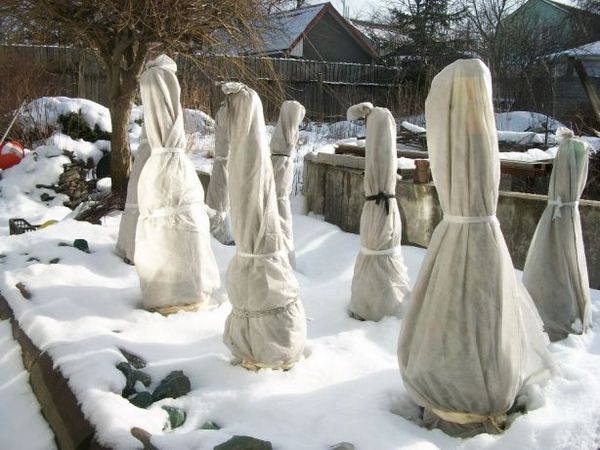

- The culture is covered with a wood box with walls in a lattice, on top of which a layer of any heat insulator (penoplex, lutrasil, spunbond) is folded. The released installation is thrown with dry foliage and wrapped in cellophane. Yucca, which has been named in such a “hut”, preserves the leaves and is rapidly reviving.
- Yucca leaves are raised and then tied to the trunk, then I wrap the culture with a rug. The base of the tree is warmed with a cover of fallen leaves. To avoid freezing of the crown, it is possible to throw a covering material over it. In the spring, the tree gets rid of its shelter, removes outdated, chipped leaves and fertilizes it with complex mineral subcrustas.
Uncovered garden yucca can withstand frost down to -23 ° C, but in this variant it loses all leaves, which will take at least 2 months to renew.
Blooming and why does not yucca bloom?
Ripe yucca blooms with beautiful snow-white flowers with creamy yellow or wheat color, they look like bells in shape. A very large number is placed on one leg, which is why the plant has excellent decorating characteristics.
A multi-colored panicle, from 0.5 m to 2.5 m long, emerges from the middle of a deciduous rosette. As a rule, it stands straight, but it can go down due to the severity of the flowers. A culture grown in a garden with an abundance of warmth and sunshine will delight you with personal rich bloom.
The plant usually blooms in the second or third year, very rarely in the 1st.The flowering period lasts quite a long time - up to 3 weeks and happens just in June-July.
Why doesn't it bloom?
Yucca, as a rule, will not be able to bloom due to the frosty winter factor, if its above-ground part is wounded by the cold.
There are options when it blooms in the fourth or fifth year after planting. Often the bush does not bloom due to lack of light when landed in partial shade.
Yucca filamentous planting in the ground
Yucca should be planted with gloves on, as the edges of the leaves can injure the skin of the hands. It is carried out in several stages:
- it is recommended to dig the planting hole in the fall;
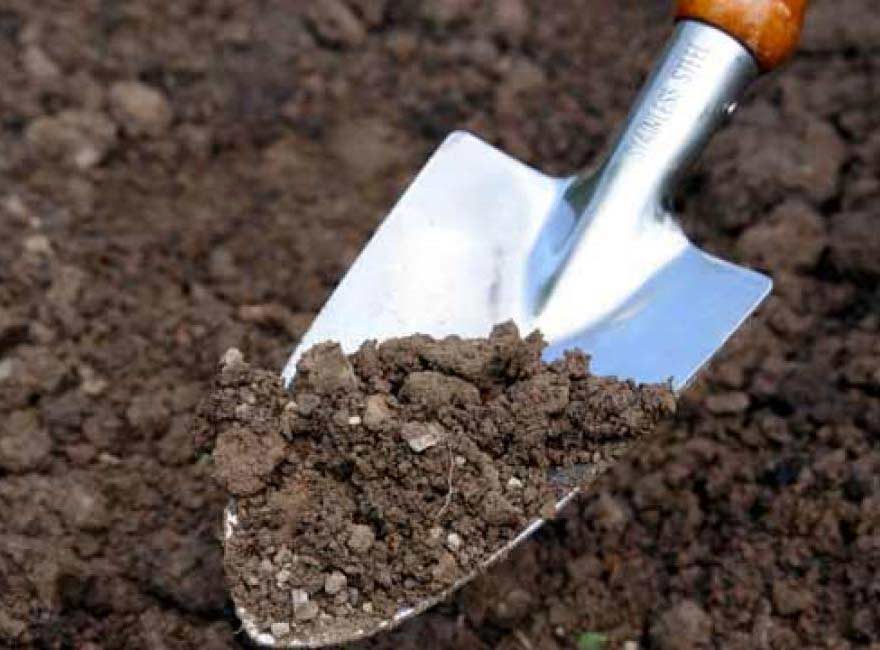

- if a purchased seedling is used for planting, then before planting, the plant should be hardened, taking it outside for 10-14 and gradually increasing its stay in outdoor conditions;
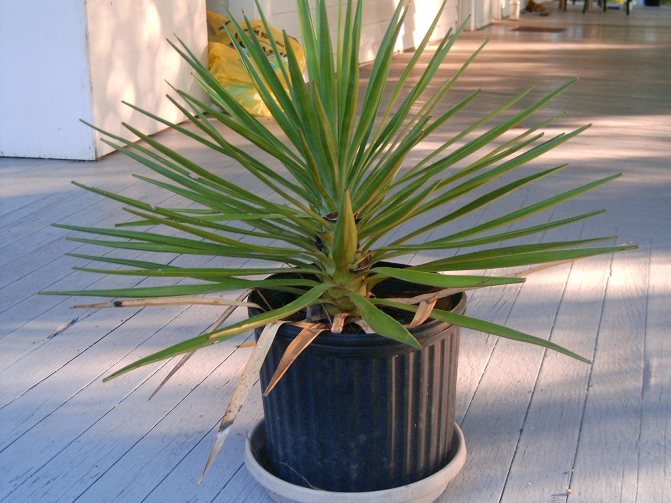

- just before planting the yucca, a layer of gravel should be poured onto the bottom of the pit for drainage. From above it must be sprinkled with ash and soil;


- place the seedling in the center of the pit, and cover with soil mixed with sand, lightly pressing it;
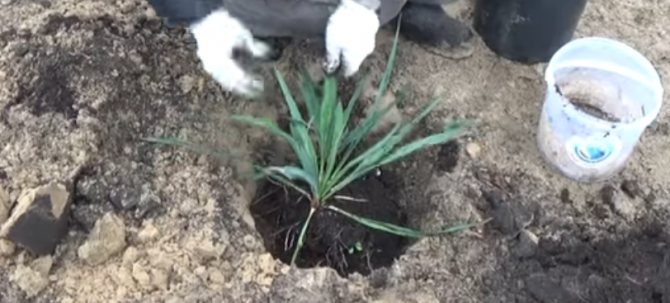

- water the yucca, pouring water under the seedling so that it does not hit the outlet of the plant.


Time for transplant
The appropriate time for a transplant must be calculated depending on the region of its location. So, in the southern regions, the yucca bush is transplanted in the early autumn period, when the heat subsides. When transplanting in the spring, it is worth considering that high temperatures can have a detrimental effect on the plant. In temperate and cool climates, on the contrary, transplanting is more desirable in March-April.
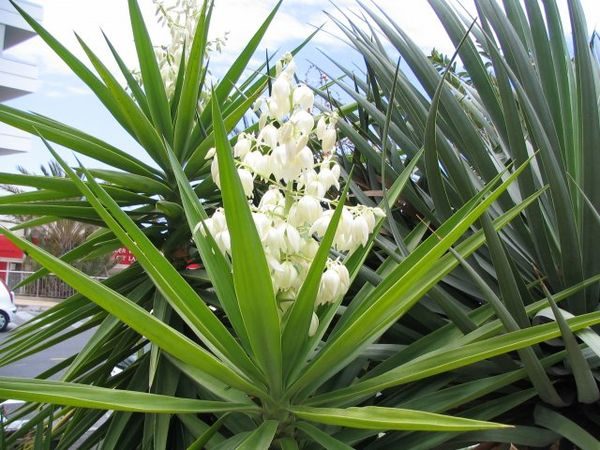

What Yucca Loves:
This unpretentious tropical plant will not cause much trouble when growing. She loves the sun and grows even on nutrient-depleted soils.
a place
Yucca thrives best when planted in open, well-lit, elevated areas. She can also tolerate short-term light partial shade. When planted in shaded areas or low-lying areas, yucca loses its external attractiveness, stretches strongly, its rosettes become thin and friable from lack of light, and the leaves of variegated forms turn pale.


priming
In the wild, yucca is a semi-desert plant, so it is unpretentious to the quality of the soil and grows well on sandy, rocky and calcareous soils. When planting it in a flower bed, it is recommended to use a loose soil substrate, consisting of leafy and soddy soil, sand or small stones, humus. If heavy clay or acidic soils prevail on the site, sand and lime should be added to the soil before planting yucca.
Attention! Yucca does not tolerate stagnant moisture, therefore waterlogged, swampy or heavy soils are not suitable for it.
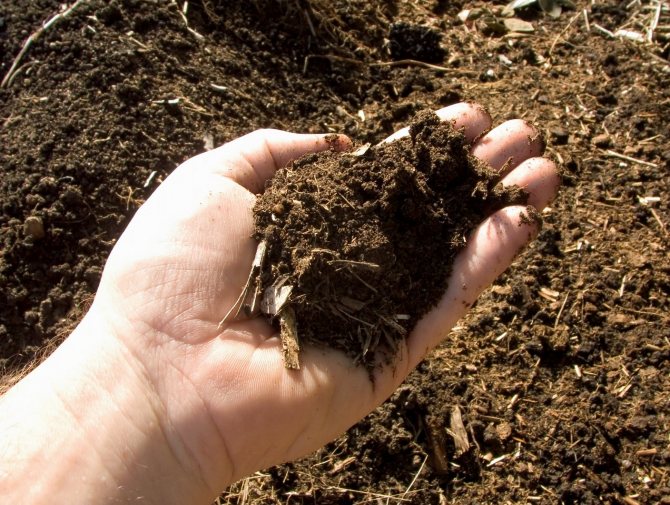

planting depth
The size of the pit intended for planting a yucca depends on the size of the seedling. On average, it should be twice the root system of the plant. For young plants, a pit of 50 × 50 cm is quite suitable, for large adult plants - approximately 100 × 100 cm.At the bottom of the pit, it is imperative to equip a drainage layer using gravel, broken brick or expanded clay for this. From above, the drainage layer must be sprinkled with ash and soil. The average planting depth of yucca is 10-15 cm for young seedlings, 40-50 cm for large ones.


watering
Withstanding heat and drought well, yucca needs moderate watering. An indicator that this plant is experiencing a moisture deficit is the sagging of the fibers on the leaves in filamentous yucca and curling of the leaves in other species. Watering exotic, water must be poured only at the root, trying to avoid water getting into the middle of the outlet. It is important to remember that an excess of moisture in the soil leads to rotting of the roots of the yucca.
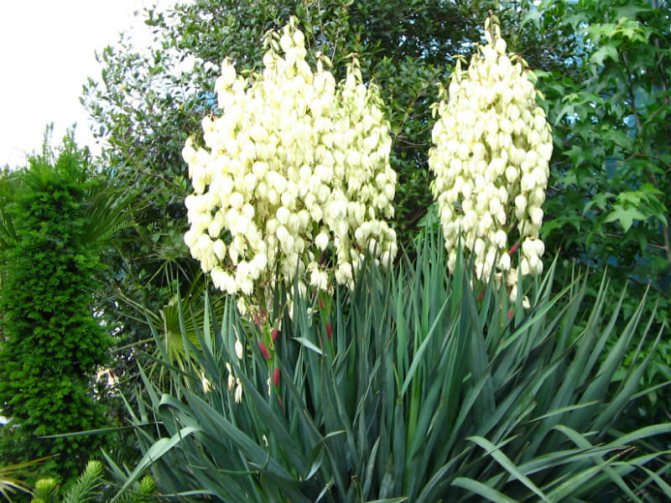

feeding
For feeding young plants, it is recommended to use complex mineral fertilizers - ideally, special fertilizers intended for succulents are suitable. They should be brought in at the end of spring, and then again at the end of summer. Starting from 3 years of age, organic fertilizers can be used to feed yucca, applying them in April. The next top dressing is recommended in June - before flowering, the last one - at the end of flowering.


Growing and care in the open field - watering and feeding
Experienced gardeners know that garden yucca is not a capricious plant, but planting a palm tree and caring for it is a very painstaking task that requires a competent approach. The fact is that this tropical plant does not really need attention to itself: in abundant watering, in frequent feeding. The soil should be moistened only when its top layer is clearly dry. In a particularly hot period of the year, it is recommended to spray the top of the yucca so that the leaves do not dry out and wither. Such procedures must be done either in the morning or in the evening, but in the midst of the sun it is impossible, otherwise the yucca may simply burn out.
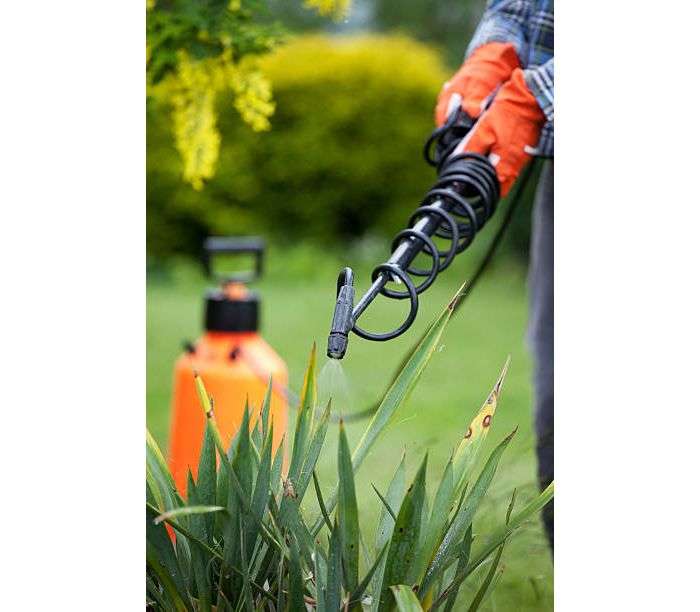

Yucca flower, how to care for a plant outdoors when it is actively growing? Yucca is most rapid in its development in spring. It is then and only then that she needs additional nutrients. Top dressing should be one-time and in minimal quantities. Liquid humus or compost are ideal fertilizers. You can even use minerals intended for succulents. Such feeding can be foliar: the lower part of the plant is abundantly sprayed with a liquid solution of fertilizers.
Yucca diseases, how to treat
Usually, yucca is not sick with anything, but the hot dry summer can cause it to be attacked by pests:
- spider mite;
- whitefly;
- scabbards;
- thrips;
- mealybug;
- aphids.
You can get rid of them by treating the plants with insecticides. From home remedies, treating bushes with a solution of ash and laundry soap will help to cope with pests.
In rainy, damp summers, yucca can suffer from a slug infestation. High soil moisture also contributes to the development of fungal diseases and bacterial rot. Most often, yucca is exposed to:
- necrosis;
- gray rot;
- cercosporium leaf blight.
It is possible to cope with such pathogenic infections only with the help of fungicides and subject to timely treatment.
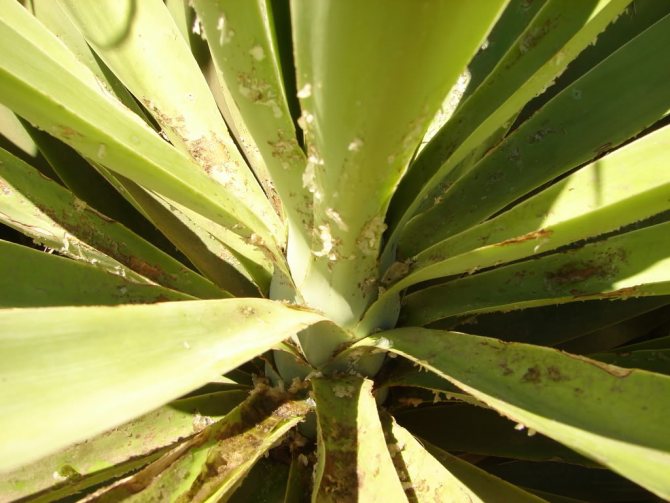

Pests and diseases
Yucca is not afraid of various pests and infections.
Usually it is attacked by aphids, if it is in the area on neighboring plants. It is eliminated with infusions of herbs, a solution of laundry soap, wiping all the leaves and inflorescences with it. You can also use insecticides.
Pests are dangerous for her: scale insects, mealy worms and spider mites. But with good care and normal growing conditions, infection and attacks are very rare.
If the plant is attacked by insects, white or brown spots appear on the leaves, it becomes lethargic and stops blooming.
Of the diseases, lesions of various types are considered more dangerous by a fungus - rotten spots form on the leaves, the stem becomes soft. It is necessary to cut off the affected areas of the leaves, treat the soil around the trunk and the plant itself with a fungicide.
Why isn't yucca blooming?
Often, an adult plant, strong and producing good growth, refuses to bloom. Some varieties begin to bloom quite late, this nuance should be taken into account.
To make the yucca bloom, it is necessary to lay a double dose of superphosphate in the ground in the fall. During the winter, it is absorbed by the roots and by the spring the plant is saturated with nutrients, which will stimulate the appearance of flowers.
The lush blooming yucca is an adornment of any personal plot.A beautiful and unpretentious exotic guest pleases the eye with a blooming panicle with bells almost all summer.
Did you like the article? Show it to your friends:
69
How to feed yucca for abundant flowering
The flowering period of yucca falls in mid-June and lasts about a month. To provide her with the opportunity to abundantly form large flower buds during this period, it is recommended to add superphosphate fertilizers to the soil in early June in the area where this exotic grows.
When to transplant homemade yucca
The false palm tree grown in a pot definitely needs periodic replanting. If you do not follow it, then this can lead to unpleasant consequences:
As a result, the plant becomes weak, stops growing actively, and loses its attractive appearance.


It is recommended to replant a young yucca once a year, since the root system of the flower grows quickly and soon begins to feel cramped in the old pot. The new container should be 3 cm larger in diameter. The plant is five years old and then transplanted no more than 1 time in 3 years. The pot is already choosing a larger one with a margin of volume.
The best time for transplanting is the end of February - early March. During this period, the plant has not yet transgressed to active vegetation and will be able to normally endure the change of "place of residence". If the moment was missed, it is allowed to change the pot in the spring and summer. Autumn and winter are not suitable for transplanting, since the yucca will give all its strength to rooting and will not be able to properly prepare for the cold season.
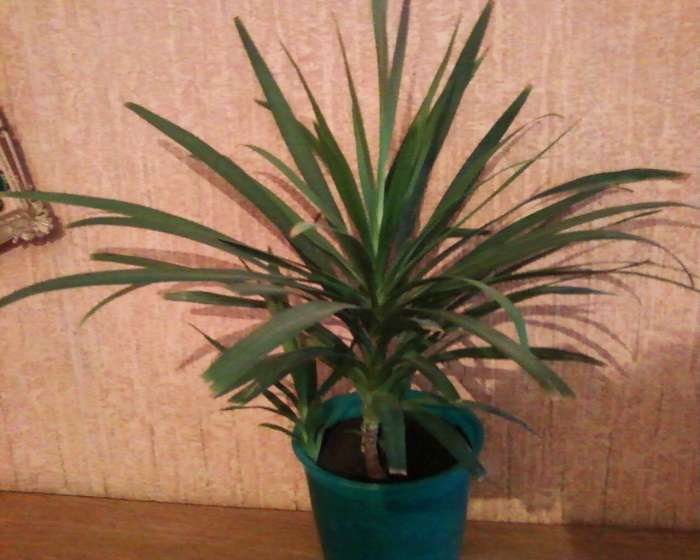

A yucca transplant at home is performed by the transshipment method, which includes the following steps:
- Selection of the correct size pot, the diameter of which will be at least 3 cm larger than the previous one.
- Laying a drainage layer on the bottom of the container using the materials indicated above.
- Filling the drainage layer with new soil (no more than 2 cm in height).
- Removing the yucca from an old pot along with a clod of earth in which the roots are located.
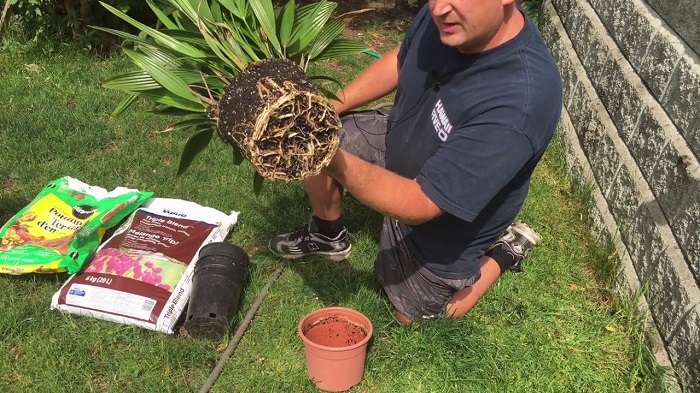

You should refrain from feeding yucca for some time, giving the plant time to adapt.
Yucca in the fall, how to prepare a yucca for winter
Complex feeding, applied at the beginning of autumn - 30-40 days before the onset of cold weather, will allow the plant to prepare for winter. Snow that suddenly fell in late autumn or early spring is not terrible for yucca. Long-standing frosts and a long-lying thick layer of snow are much more dangerous for her.
Attention! To prevent the plant from suffering under the weight of the snow that has fallen, it is recommended to tie it up.
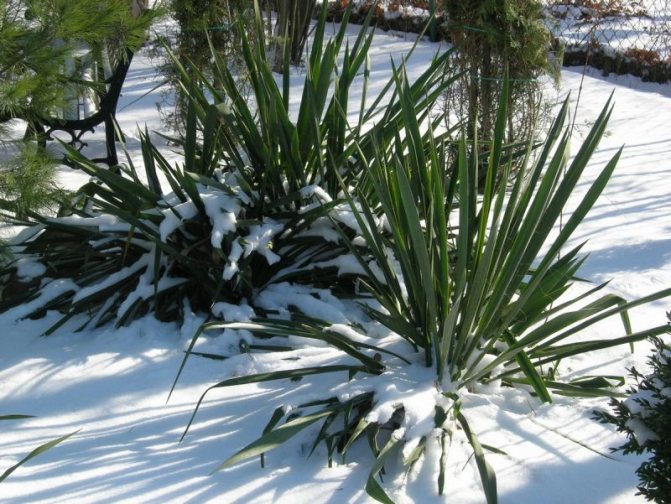

How to cover a yucca for the winter
Yucca filamentous, like other varieties of this exotic grown in temperate climates, tolerate winters quite well, withstanding up to -15 ° C, and being sheltered, even up to -30 ° C. For this reason, yuccas growing in open ground do not they dig it up, but simply cover it at the end of October - beginning of November. It is advisable to do this in dry weather. The way how to cover the yucca for the winter depends on the availability of covering material and the size of the plant. Small yuccas should be tied with twine, gathering the leaves together, and then wrapped in burlap or agrofibre, and covered with a box. On top of it, lay spruce branches or a layer of fallen leaves and fix everything on top with a covering material - roofing material or foam. Large yuccas can be insulated by covering the soil around them with a layer of leaves and placing boards on top. The plant itself must be collected in a bundle and tied with a rope, then cover it with polyethylene on top, and cover the base of the trunk with soil.
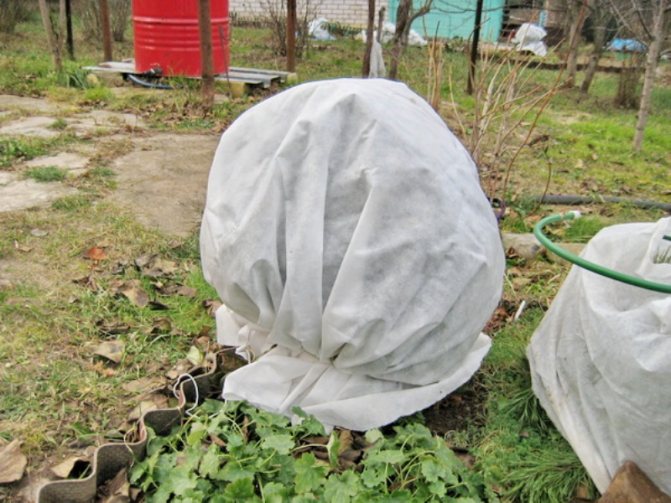

Attention! At the end of March, the shelter must be opened to prevent mold growth.
Let's summarize
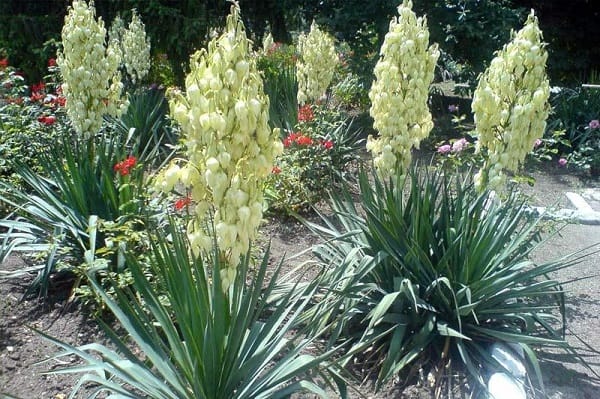

- Garden (street) yucca is a herbaceous ornamental plant with large lanceolate leaves and a very noticeable white inflorescence, consisting of many bells.
- When planting a plant, two points are considered important: firstly, the soil should not be too heavy, and secondly, choose a sunny and not wet area for a flower.
- This perennial can winter in our garden when the frost is down to -20. In the southern regions, you do not even need to cover the yucca, only the leaves should be tied in a sheaf to avoid breaking off due to snow.
Did you know that besides only decorative qualities, filamentous yucca also has medicinal properties? Which ones and how to use them, the mistress of an old and very well-groomed, flowering bush will explain:
Yucca is a perennial evergreen that is grown in a room or garden. Outdoor specimens tolerate frost well, but in harsh regions they require additional shelter for the winter. Transplanting garden and room yucca has its own characteristics that you should be aware of.
Yucca after winter, yucca care in spring
With the onset of spring, after the winter shelter has been removed from the yucca, it must be untied and inspected for damage and lesions by fungal diseases. Then prune dry leaves to allow the bush to open up. In early spring, it also needs to be fed with mineral or organic fertilizers, providing the plant with the opportunity to actively develop.
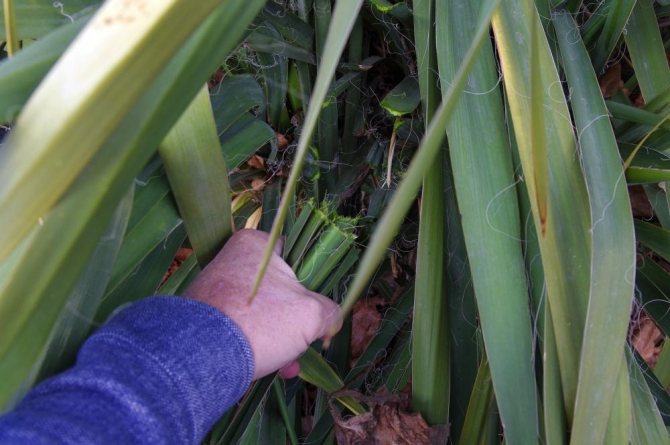

How to properly prune a yucca
Yucca pruning is done with a sharp and clean knife, subject to the following conditions:
- the plant must be watered 1-2 days before pruning;
- the cut of the stem is made 8-10 cm below the beginning of the growth of the leaves so that the bark does not peel off or the formation of splits;
- all cuts must be treated with a fungicide or sprinkled with a wood corner. The hemp of old plants can be treated with garden pitch.
After pruning, after 3 weeks, new shoots will appear on the old bush. If the plant is mature and healthy, then you can leave up to 5 such shoots on it, and the rest should be removed. In small yuccas, no more than 2 protruding buds are left. The cut off top is also used as a seedling, only for this it must first be rooted by planting it in a greenhouse.


Yucca pruning for beauty and rejuvenation
Yucca pruning is carried out in order to rejuvenate the plant and obtain new growth. To awaken the dormant lateral buds, in early spring, after the snow melts, the main stem is cut off, stimulating the development of lateral buds, from which new rosettes will develop in the future. If there is no need to grow new shoots, the plant wintered well, only bad and dry leaves are removed.
Yucca is very decorative when it grows in one stem. With proper care, the height of the peduncle exceeds 1.5 m, the number of beautiful large flowers can reach 250 pieces per plant. Before subjecting a culture to a haircut, think about whether it is really necessary to resort to this procedure.
Usually, the yucca is pruned after flowering, removing faded stems and bad foliage. To make the plant decorative, the leaves are not completely cut off, retreating a distance of 3-5 cm from the trunk, so the trimmed yucca will not look naked, the trunk will seem to be in scales. Even in winter, yucca in the snow decorates the garden, becoming a striking element in the landscape design of your site.
Why does yucca dry, how to save a yucca
The appearance of the leaves is an indicator of the correct care of the yucca. As soon as there are any problems, it is immediately visible on its leaves.
- The dried brown tips of a yucca indicate a lack of moisture in the air and the presence of cold drafts. In the first case, spraying the plant will help correct the situation, in the second, transplanting it to a more comfortable place.
- The formation of brown spots on the leaf plate is a sign of a fungal disease that develops as a result of waterlogging of the soil caused by excessive watering, insufficient drainage, and low aeration of the soil substrate.
- The appearance of light dry spots on the leaves is caused by an excess of sunlight. You can avoid them by creating a slight partial shade to the plant.
Watering mode
Garden yucca should be watered immediately after planting; in the future, yucca requires rare watering, with complete drying of the soil in order to avoid root rot. In this case, you should avoid getting moisture into the outlet - because of this, rotting of the top may begin, which then must be removed. If this is not noticed in time, the yucca may die.
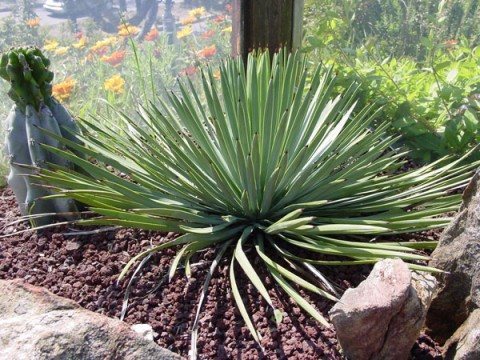

On a note!
Loosening of the soil is carried out about every other day in order to avoid rotting of the plant, which occurs due to rains, as well as to improve the flow of moisture to the vegetative organs, especially in hot weather, when yucca loses a large amount of moisture. It is also recommended to systematically spray the plant.
Yucca leaves curl, what to do
Hypothermia or lack of moisture is the main reason yucca leaves curl. If the edges of the plant are twisted, but not darkened, it means that the soil is too dry and the plant needs urgent watering. The darkening of the edges of the leaves and their twisting indicates that the yucca is frozen, in which case the damaged leaves must be removed, and the plant itself must be insulated by covering it with agrofibre or other covering material.


How garden yucca reproduces
Yucca reproduces by seed and vegetative means. Yucca propagation by seeds takes place with the participation of butterflies of the Pronuba family, which pollinate flowering plants. Ripe seeds are harvested in August and planted for seedlings in February. In open ground, seedlings are planted only in the second year. Since the process of obtaining new yucca seedlings by the seed method is too laborious and time-consuming, it requires the creation of special conditions, then for its cultivation in gardens, a simpler and more productive method is practiced - vegetative. For vegetative propagation of yucca, several methods are used.
- Cuttings. To do this, in the spring, the apical shoots are cut at an angle, the cut points are treated with activated carbon. The lower leaves are removed from the cuttings, leaving 4-5 leaves at the very top. After that, the cuttings are dried in the shade for 20 minutes. and planted in a moist substrate, buried 5-7 cm into the soil. When planting cuttings, they must be placed at a distance of 4 cm from each other. Then cover the entire planting with foil or each individual stalk with a jar. If grafting is carried out at the end of summer, they are left to winter, covered with leaves and agrofibre, and in the spring they are transplanted to a permanent place.
- Root offspring. For this, the mother bush is dug up in the spring or at the end of summer. Lateral sockets with part of the root system are separated from it. Separated young shoots are planted in a fertile, well-aerated soil, having previously treated the root system with a growth stimulator, watered and slightly shaded. You can separate the root suckers from the mother plant every 3-4 years.
- Parts of the trunk. This method is used when there are dormant buds on the stem. To do this, cut the trunk with the buds into pieces 10 cm long. Lay the finished stem cuttings horizontally on a previously prepared and moistened soil, press into it. It should be sprayed every day of planting. After 2-3 weeks, young shoots will appear at the site of the buds. After that, the stem cuttings are removed from the ground and cut into pieces, the cut sites are treated with activated carbon and dried for 20 minutes, and then planted in moistened soil, covered with a jar or film.After 1-2 months, the rooted cuttings can be planted in a permanent place.
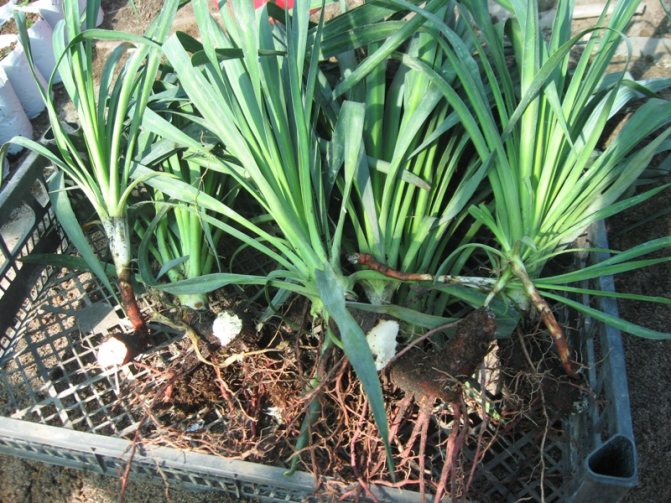

Yucca or false palm
Plants from exotic countries are pretty well rooted in our latitudes, and now their presence in the home or office is not surprising. The most attractive species are those that do not require special care and formation in the process of growth. Such plants include yucca or, as it is also called, false palm.
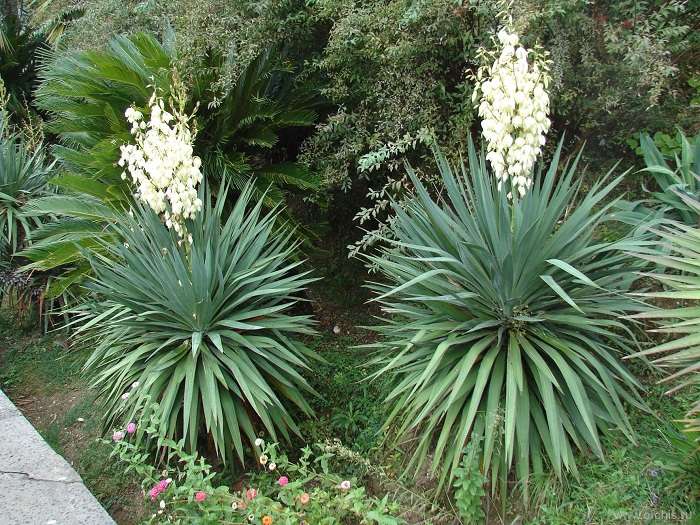

The flower was brought from Central America, and received the name for its external resemblance to a palm tree. When growing yucca, you do not need to devote a lot of time to care and do frequent watering. The plant prefers a moderate amount of moisture in the soil and at the same time has a positive effect on the indoor air: it cleans it from pollution.
In an earlier period of human history, the false palm was used as a raw material for making clothes, soap, and other items. The flower was also called Adam's needle, a Spanish dagger.
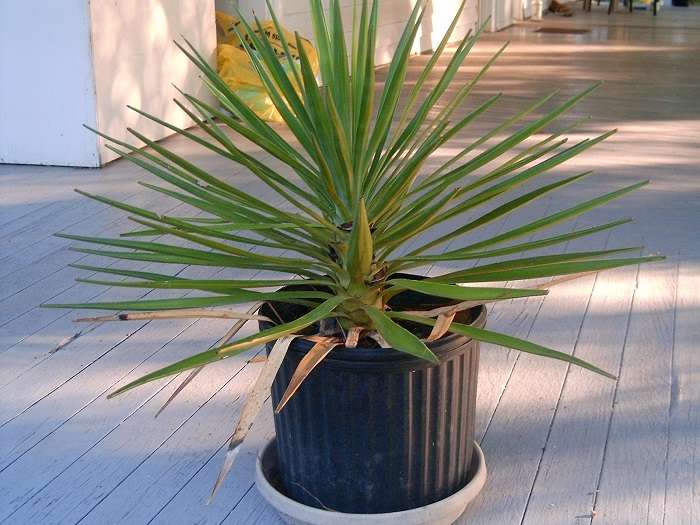

Yucca prefers to be in the light and warm. The ideal option for placing it would be a south-facing window. The plant tolerates dry climates well, which means that it does not need to be over-watered. It is necessary to moisten the earth only when its drying out is noticeable. Spraying of leaves is carried out up to 2 times a week. The most important condition for the successful growth and development of yucca is the correct planting and composition of the land. Based on this, before starting the procedure, you should carefully study the requirements and strictly follow them.
How to root a yucca in water
The cut tops of the yucca can be rooted by placing them in water. For this cutting site, it is necessary to air dry for half an hour, and then place the cutting in boiled cooled water so that it covers only the part of the trunk free of leaves. Thus, parts of the trunks with dormant buds can also be rooted. In stem cuttings, the lower sections are treated with a growth stimulant, and the upper ones - with a fungicide or activated carbon, after which I put them in water, so that the buds are above the water. It will take about 1-2 months for new roots to grow back, after which the cuttings can be transplanted into the ground to a permanent place.
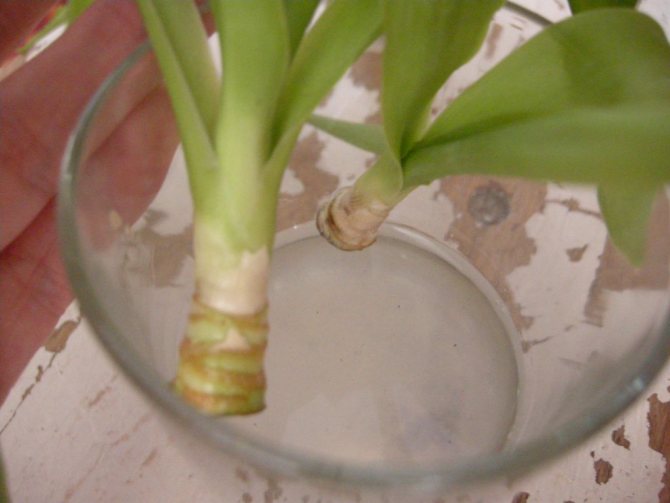

Video reproduction of Yucca Sadovaya
This video will help you learn more about the subtleties of the reproduction of yucca garden.
Since yucca is very unpretentious in its agricultural technology, it is imperative to allocate a place in a flower bed or a house plot for planting it. And she will thank you with spectacular flowering.
General characteristics of the plant
Yucca leaves are quite tough, 25 to 100 cm long and 1 to 8 cm wide, and are predominantly green in color. They can be straight or drooping in shape, with a pointed end and a smooth or serrated leaf edge. In some varieties, the leaves are arranged in bunches or collected in a rosette.
Yucca flowers form peculiar panicles, on which there are about three hundred buds with a very pleasant aroma. The size of the flowers of this plant reaches about 7 centimeters in length.
The fruits of the garden yucca are fleshy berries that are sometimes edible, but when planted, then grown and properly cared for in Belarus, the plant practically does not produce seeds.

